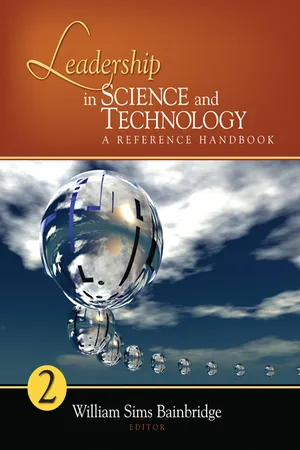
- 984 pages
- English
- PDF
- Available on iOS & Android
Leadership in Science and Technology: A Reference Handbook
About This Book
This 2-volume set within the SAGE Reference Series on Leadership tackles issues relevant to leadership in the realm of science and technology. To encompass the key topics in this arena, this handbook features 100 topics arranged under eight headings. Volume 1 concentrates on general principles of science and technology leadership and includes sections on social-scientific perspectives on S&T leadership; key scientific concepts about leading and innovating in S&T; characteristics of S&T leaders and their environments; and strategies, tactics, and tools of S&T leadership. Volume 2 provides case studies of leadership in S&T, with sections considering leadership in informal communities of scientists and engineers; leadership in government projects and research initiatives; leadership in industry research, development, and innovation; and finally, leadership in education and university-based research. By focusing on key topics within 100 brief chapters, this unprecedented reference resource offers students more detailed information and depth of discussion than typically found in an encyclopedia entry but not as much jargon, detail or density as in a journal article or a research handbook chapter. Entries are written in language and style that is broadly accessible, and each is followed by cross-references and a brief bibliography and further readings. A detailed index and an online version of the work enhances accessibility for today's student audience.
Frequently asked questions
Information
Table of contents
- Cover
- Contents
- Foreword
- Introduction: The Scope of Leadership in Science and Technology
- About the Editor
- PART I: Scientific Approaches
- 1 - Anthropology
- 2 - Cognitive Science
- 3 - Economics
- 4 - Futures Studies
- 5 - Linguistics
- 6 - Network Science: Theory, Tools, and Practice
- 7 - Political Science
- 8 - Social Psychology
- 9 - Sociology
- 10 - Urban and Regional Planning
- PART II: Key Concepts
- 11 - Controversies
- 12 - Creative Destruction
- 13 - Design Science
- 14 - Diffusion of Innovations
- 15 - Group Processes
- 16 - Human Subjects Research
- 17 - Mechanizing Ethics
- 18 - National Preeminence
- 19 - Research Groups
- 20 - Research Misconduct
- 21 - The Scientific Method
- 22 - Social Complexity
- 23 - Sustainability
- 24 - Technology Convergence
- PART III: Contexts
- 25 - Fallibility and Authority
- 26 - Inclusive Technologies
- 27 - Intellectual Property Rights
- 28 - Moral Exemplars
- 29 - Multicultural Teams
- 30 - New Media
- 31 - Political Economy
- 32 - Product Liability
- 33 - Productivity of Invention
- 34 - Public Attitudes Toward Science and Technology
- 35 - Religion and Science
- 36 - Science Careers
- 37 - Social Movements
- 38 - Virtual Organizations
- PART IV: Tactics and Tools
- 39 - Computer Simulation
- 40 - Creative Cognition
- 41 - Followership
- 42 - Gatekeeping
- 43 - Management Tools for Innovation
- 44 - Peer Review
- 45 - The Precautionary Principle
- 46 - Program Evaluation
- 47 - Science of Science Policy
- 48 - Strategic Thinking
- 49 - The Triple Helix
- 50 - Workshops and Networks
- PART V: Discovery and Debate
- 51 - Advice to the U.S. Government
- 52 - Artificial Intelligence
- 53 - The Chicago School of Sociology
- 54 - The Climate Change Debate
- 55 - Fuzzy Logic
- 56 - The Harvard Department of Social Relations
- 57 - Human Dimensions of Biology
- 58 - Natural Disasters
- 59 - The Psychoanalytic Movement
- 60 - Quantum Mechanics
- 61 - Science Fiction
- 62 - Service Science
- 63 - The SETI Institute
- 64 - Sociobiology
- 65 - Spectral Music
- 66 - Transhumanism
- PART VI: Collaboratories
- 67 - Blacksburg Electronic Village
- 68 - Computer Tomography Virtual Organization
- 69 - Data-Intensive Astronomy
- 70 - Human Relations Area Files
- 71 - Information Technology Research
- 72 - The Mars Exploration Rover Mission
- 73 - The Perseus Project
- 74 - Polar Research
- 75 - The Protein Data Bank
- 76 - Social Science Data Archives
- 77 - University Corporation for Atmospheric Research
- PART VII: Technology Development
- 78 - Apollo Project
- 79 - Avatars
- 80 - The Digital Library Initiative
- 81 - Energy Program Evaluation
- 82 - Environmentally Compatible Textiles
- 83 - From ARPAnet, Through NSFnet, to Internet
- 84 - Geographic Information Systems
- 85 - Harpsichord Makers
- 86 - The Manhattan Project
- 87 - National Nanotechnology Initiative
- 88 - Open Source Software Development
- 89 - Robotics in Japan
- 90 - Television
- 91 - The V-2 Rocket Program
- 92 - Vaccination
- PART VIII: Education
- 93 - American Association for the Advancement of Science Education Programs
- 94 - Educational Games and Virtual Reality
- 95 - Engineering Education
- 96 - International Comparative Studies in Education
- 97 - National Science Digital Library
- 98 - The New Math
- 99 - The Open University (UK)
- 100 - Undergraduate Biology Education
- Index